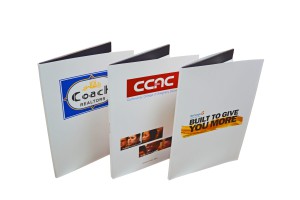Last month we were one of many attendees at the ASI show in New York City’s Jacob Javitz Center. ASI (Ad Specialty Items) focuses on promotional goods, such as pens with your name on them, refrigerator magnets, and now our brand new, patent pending, Make Your Own Portfolios and K-Pad Wrappers.
We received a positive response, but the truth is that while we like them and people at the show agree that these would be great and very affordable as a:
- Freshman Orientation Kit
- Sales Leave-behind
- Seminar Giveaway
that doesn’t mean that anyone is going to buy them. Breaking a new product into the market is an uphill battle, and one of the most crucial weapons in this product vs. market war is the sales follow-up call.
Why the Follow-up is Crucial
After the show, we (and everyone else) began compiling our list of new contacts. Then we sent out small packages with a letter and marketing materials. For those who made special requests at the show – custom samples, for example – we began working on them immediately.
At this stage we met the new customer and sent a follow-up, but this is not enough. At this point, you have not differentiated yourself from your competition, nor have you created any kind of impression on which a relationship will be made, and business is all about relationships.
After sending the products we began reaching out to people to make sure they received them, and this is where it all came to light.
What Happened When we Followed up
Of some of the calls made, two that really stood out to us were to Dave Manthei of P A C Imaging in Niagara Falls, NY, and Nicole Hills of Learn Inbound Marketing outside of Ocean City, MD.
Dave had asked for samples specifically made for Niagara University, a Division I Jesuit school on the American-Canadian border. We sent them out on April 11th, alerted him that he could expect them, and then reached out to him via email the next week to confirm they arrived. We received no reply so the next week we sent another email (just like everyone else who met him at the show), noting that if there was no reply again calling would be best.
When we called Dave hadn’t received the package. Given the date, though, he then realized it was in the sea of other ASI-show goods. As he searched through all of the things that were sent to him he found ours, opened it, and confirmed that he found them. In addition to this, he had a meeting at Niagara University that afternoon!
Had we not have followed up with a call after the emails, he would have been going there without our product, and the chances of making this great new relationship would have been zero.
On Nicole Hills: we only had her email so we followed up with her but did not receive a reply. While some people pretend to be in business, there is no way that an inbound marketing specialist like Ms. Hills would come to the ASI show from Maryland just to play the part of a business woman, so we looked up her phone number finding that her email account sorted our messages to SPAM.
After speaking, she recalled our products and requested samples for the Pohanka Auto Group as well as the Hilton Hotel in Ocean City, the former of which she is meeting with this month.
You can be assured of two things here: 1) she will receive her samples in time for her meetings, and 2) persistent following up made the difference.
Final Notes on Following up With Sales and Other Calls
We live in a world where people are being overwhelmed with communication. The result is that when we make that first point of contact (meeting at the ASI show), we are not making any impact in most cases.
We should know this because it’s the same way for us; people talk to us about a product, service, or idea, and when they bring it up again we need to be reminded.
The second point of contact (alerting them that we’re sending samples) doesn’t do much except remind them of something they don’t remember.
However, when we make the third point of contact (the samples are received) they remember us, and now have something tangible to make the association. For us here at Kleer-Fax, we are the custom folios and K-Pad Wrappers.
Our fourth point of contact is when we make sure they received the product and inquire if they need anything else. Here, we are starting to form a relationship, and only at this point do we stand a chance of making a sale.
In between these four points of contact there will be missed calls, ignored emails, situations that take people away from work, and other communications gone awry. Additionally, just because we now have some kind of relationship when the fourth point of contact occurs, it doesn’t mean that a sale will be made; it just means that if they need and want what we have, a sale could be made.
The result is that we need to maintain a presence in our customers’ lives, telling them about promotions without being annoying, making sure they have the marketing materials they need, and seeing if they’d like us to assist on some sales calls when we’re in the area.
There are situations where people will come to the one making the sale, but that’s not our experience, and it’s not likely yours. We’d love to hear about your experiences in sales that have made an impact on you and your business. What do you find makes the difference between those who are in sales, and those who actually make sales?
